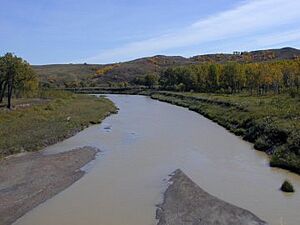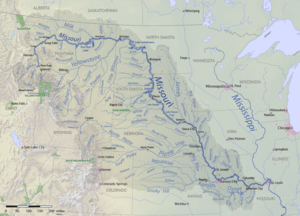Grand River (South Dakota) facts for kids
The Grand River (called Čhaŋšúška Wakpá by the Lakota people) is an important river in South Dakota, United States. It flows into the Missouri River. The main part of the river is about 110 miles (177 km) long. If you include its longest branch, it stretches for about 200 miles (320 km).


Where the Grand River Flows
The Grand River starts in northwestern South Dakota. It is formed when two smaller rivers, the North Fork and the South Fork, join together. The North Fork begins in North Dakota, while the longer South Fork starts in South Dakota.
These two forks meet near Shadehill in Perkins County. This area is close to parts of the Grand River National Grassland, which is a large area of protected land. A lake called Shadehill Reservoir is also located where the forks meet.
From there, the Grand River flows east. It passes through the Standing Rock Indian Reservation. Finally, it joins the Missouri River in Lake Oahe, which is a large reservoir. This meeting point is about 10 miles (16 km) northwest of Mobridge. The last 15 miles (25 km) of the Grand River actually form an arm of Lake Oahe itself.
The Grand River is the most northern of South Dakota's main rivers that flow west of the Missouri River. These rivers include the Grand, Moreau, Cheyenne, Bad, and White rivers. The Grand River helps drain about 5,200 square miles of the northern parts of South Dakota. Most of its water comes from melting snow.
History of the Grand River Area
The Grand River has played a role in the history of the region.
Sitting Bull, a famous Hunkpapa Lakota holy man and tribal chief, was born near the Grand River. He was born in 1831 in what was then Dakota Territory. Years later, in 1890, Sitting Bull passed away near the Grand River on the Standing Rock Indian Reservation.
The area where the Grand River's forks meet was also the site of a well-known event in 1823. A frontiersman named Hugh Glass was attacked by a grizzly bear there. This event became a famous story of survival.

